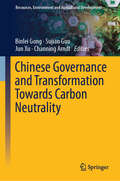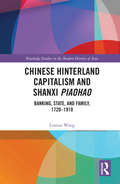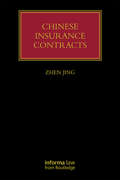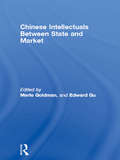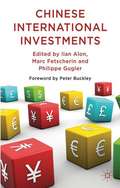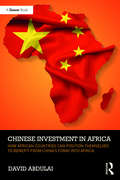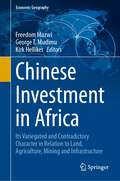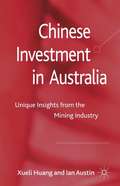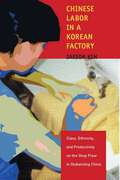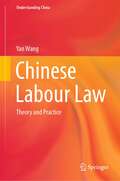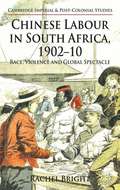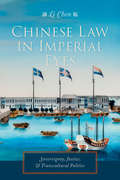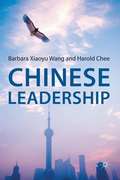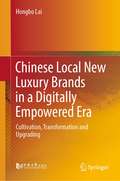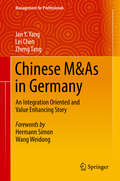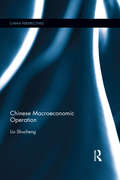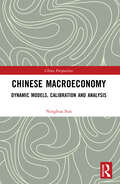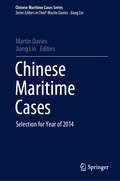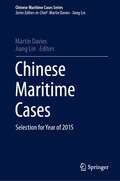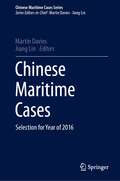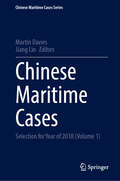- Table View
- List View
Chinese Governance and Transformation Towards Carbon Neutrality (Resources, Environment and Agricultural Development)
by Jun Xu Sujian Guo Channing Arndt Binlei GongThis book provides the first comprehensive and systematic account of the multi-level governance system adopted by China in realizing the Dual-Carbon transition. This governance system encompasses the participation of the government, the market, industry and all sectors of society, and emphasizes coordination and cooperation between all levels of government between different sectors, and between domestic and international levels. The book finds that the government can play an important leadership and guidance role in the Dual-Carbon transition. By formulating and implementing relevant policies, regulations and planning, the government can promote the process of Dual-Carbon development. Second, the full utilization of market mechanisms also plays a key role. Through measures such as establishing a carbon market and promoting carbon pricing, the market mechanism promotes the innovation and application of low carbon technologies. In addition, the active participation of industry is an indispensable factor in realizing a Dual-Carbon transition. Industry and agriculture have contributed to Dual-Carbon development by promoting the efficient use of resources and the adoption of green production methods. Finally, raising public awareness and participation in environmental protection is also indispensable, and the process of Dual-Carbon transition is effectively promoted through publicity and education, social organizations and public participation. By addressing multiple themes, this book provides a comprehensive understanding and in-depth analysis of the Dual-Carbon transition, and offers scientific guidance and policy recommendations for China's sustainable development and the achievement of Dual-Carbon goals. At the same time, the significance of this book lies in the fact that it provides reference for other countries and regions, and makes a positive contribution to global climate governance. Parts of this book's translation from its Chinese original manuscript were completed with the assistance of artificial intelligence. The author subsequently revised the content.
Chinese Hinterland Capitalism and Shanxi Piaohao: Banking, State, and Family, 1720-1910 (Routledge Studies in the Modern History of Asia)
by Luman WangThis book examines Shanxi piaohao—private financiers from the Chinese hinterland—in the economic and business history of late imperial China, forming the original theory of Chinese hinterland capitalism. Deepening the existing understanding of capitalist dynamics at work in the families and financial institutions of late imperial China, the book foregrounds the expansionist role played by Shanxi piaohao in transforming China’s market and trade from an agrarian empire to a modern nation state. In a departure for economic history, it also focuses on the histories of the people and their lifeworlds behind financial institutions, which have previously been erased by universal capitalist narratives. Persistent binary oppositions between coastal areas and hinterland; state and market; and institutions and families are each transcended in recounting the local histories of global capital in the marginalized countryside and borderlands of China. Based on a wealth of archival material and correspondence with Shanxi piaohao offices and branches, Chinese Hinterland Capitalism and Shanxi Piaohao will appeal to students and scholars of Chinese and economic history, anthropology, and postcolonial studies more generally.
Chinese Infrastructure Investments in Sri Lanka: A Pearl or a Teardrop on the Belt and Road?
by Meg Rithmire Yihao LiIn 2015, a surprise presidential election result seemed to imperil Chinese investments in Sri Lanka, which were associated with China's Belt and Road Initiative to build global infrastructure. In the previous decade, China had undertaken two major projects in the country: the construction of a port in the poor district of Hambantota (also the previous president's hometown), for which Sri Lanka borrowed 1.2 bn USD from the China Ex-Im bank, and a major real estate project outside of Colombo. The new administration pursued renegotiation of both contracts. In 2016, a Chinese state-owned company purchased the asset of the Hambantota port, generating concerns about sovereignty in Sri Lanka and Chinese naval ambitions in Delhi and Washington, DC. This case explores the dynamics of Chinas ambitious Belt and Road Initiative, a large-scale infrastructure and connectivity project launched under its powerful leader, Xi Jinping, as well as the politics and economics of sovereign borrowing in the age of Chinese lending. Did Sri Lanka fall victim to a sort of "debt diplomacy," or did the Chinese side fail to understand Sri Lanka's domestic political landscape? Was the sale of the asset the right choice for Sri Lanka? The right investment for China Merchants Group, which bought the 99-year lease?
Chinese Insurance Contracts: Law and Practice (Lloyd's Insurance Law Library)
by Zhen JingChinese Insurance Contracts: Law and Practice is the first systematic text written in English on the law of insurance in China. This book offers a critical analysis of the major principles, doctrines and concepts of insurance contract law in China. At every point the analysis discusses the principles of the Insurance Law in detail, referring where appropriate to decided cases and also drawing attention to external influences. Readers are guided through the complexities of Chinese law in a clear and comprehensive fashion, and – significantly – in a manner that is accessible and meaningful for those used to a common law system. This book presents a comprehensive picture of Chinese insurance contract law, to facilitate a wider understanding of the relevant rules of law. Elements of insurance contract law are critically examined. In addition, this book presents rules of law on some special types of insurance contract, such as life insurance, property insurance, liability insurance, motor vehicle insurance, reinsurance, and marine insurance. The deficiencies and shortcomings of the law and practice will be identified and analysed; suggestions and recommendations on how to reform the law will be presented. Chinese Insurance Contracts also offers legal and practical advice to insurance professionals on how to draft clauses to avoid contractual pitfalls. It also uses cases to illustrate the difficulties which can arise in applying the principles in practice. This book will be essential reading for insurance companies and legal practitioners looking to do business in China, as well as reference for Chinese lawyers practising insurance law. It will also be a useful resource for students and academics studying Chinese law.
Chinese Intellectuals Between State and Market (Routledge Studies on China in Transition #Vol. 17)
by Edward Gu Merle GoldmanThis edited volume describes the intellectual world that developed in China in the last decade of the twentieth century. How, as China's economy changed from a centrally planned to a market one, and as China opened up to the outside world and was influenced by the outside world, Chinese intellectual activity became more wide-ranging, more independent, more professionalized and more commercially oriented than ever before. The future impact of this activity on Chinese civil society is discussed in the last chapter.
Chinese International Investments
by Marc Fetscherin Ilan Alon Philippe GuglerThis book provides authoritative academic and professional insights into the strategies of Chinese Foreign Direct Investments in Europe, Asia, Africa and the Americas. Distinguished authors from across the world will make a contribution to the growing literature on OFDI (outward foreign direct investment) from China.
Chinese Investment in Africa: How African Countries Can Position Themselves to Benefit from China’s Foray into Africa
by David N. AbdulaiChina leads the world when it comes to investment and influence on the African continent. The extent of Chinese investment in Africa is well known and much has been written about China’s foray into Africa. However, most of the available material has approached this issue by looking at China as the ’New Colonialist’ – more interested in Africa’s vast natural resources than working in partnership for sustained development. Whilst China’s interest in Africa’s resources is evident, it is just half of the story. China’s foray into Africa goes beyond its appetite for natural resources and into the realm of geo-politics and international political economics. For example, China is all too aware of how it can cultivate Africa’s support on global issues at the United Nations and at other international fora. Breaking free from the binary arguments and analysis which characterize this topic, Professor Abdulai presents a refreshing perspective that China’s foray into Africa can produce win–win outcomes for China and Africa – if Africans really know what they want from China. Hitherto, each African country has tended to engage China with an individual bucket list; acting in isolation and not as part of a wider continent (indeed Africa and the African Union does not yet have a coordinated policy towards China). For Africa to be able to do that it needs to know where China is coming from, the factors that contributed to its awakening and success, and the benefits and possible pitfalls of this foray, in order to better position itself for a win–win engagement with China. This book will be a valuable read for policy makers, think-tanks and students of Africa-China studies programmes alike.
Chinese Investment in Africa: Its Variegated and Contradictory Character in Relation to Land, Agriculture, Mining and Infrastructure (Economic Geography)
by Kirk Helliker Freedom Mazwi George T. MudimuThis edited volume systematically interrogates the Chinese investment presence in Africa, focusing on land and agriculture, mining and other infrastructural projects. In doing so, the form and extent of Chinese debt will be brought into perspective, with comparisons made to investments in Africa emanating from metropolitan capitalism. The volume examines the development potential of these investments by focusing on the labour regimes created and the effects of investments on the land-based agricultural livelihoods of the African peasantry. This entails the use of a political economy approach which incorporates the state, international actors and local communities into the analysis, with gender dynamics also of great significance. Overall, the contributions in this volume focus on an array of African nations (with a specific focus on Zimbabwe) and they deploy a large wealth of primary field-based data collected over a number of years by established and emerging scholars living andworking on the continent.
Chinese Investment in Australia
by Xueli Huang Ian AustinAustralia is renowned for its abundance of natural resources and is one of the largest recipients of Chinese direct investment. State- and privately-owned Chinese firms have invested heavily in the Australian minerals industry to secure a supply for their domestic production. In this book, the authors provide a comprehensive review of how Chinese firms have successfully invested in the Australian mineral industry based on their extensive research and consulting experiences. They provide unique insights into the entry processes used by Chinese investors, factors contributing to their successes, lessons they have learnt, and the challenges they have encountered in managing their investment. Moreover, the book also elaborates on how the political, economic and competitive forces in both countries influence Chinese investments in Australia. It is an informative tool for domestic and international policy makers, business professionals, academic and informed readers with interests on how China's resource requirements are impacting the Australian political and commercial landscape.
Chinese Investment in U.S. Aviation
by Chad J. Ohlandt Andrew Scobell Lyle J. Morris Arthur Chan Julia A. ThompsonThis report assesses Chinese investment in U.S. aviation from 2005 to 2016. It provides context in China’s demand for aviation products and aviation industrial policies, while assessing technology transfers and impact on U.S. competitiveness. Chinese investment in U.S. aviation over the past decade has primarily involved lower-technology general aviation manufacturers that do not affect U.S. competitiveness.
Chinese Investments and the Economic Security Turn in Europe
by Francesca GhirettiFocusing on inward foreign direct investment (FDI) screening, this book provides an in-depth analysis of how European states’ economic interactions with China have become a security issue. Based on 100 interviews with scholars, journalists, policy makers, and politicians from across Europe, the book underscores the importance of the policy making process that led to the adoption of investment screening in European nations for the development of the EU's economic security approach. The book details how the economic security shift in Europe is attributed to changes such as China’s growing economic presence, the persistence of non-market practices, the loss of competitiveness, and the use of economic statecraft.
Chinese Labor in a Korean Factory: Class, Ethnicity, and Productivity on the Shop Floor in Globalizing China
by Jaesok KimChinese Labor in a Korean Factorydraws on fieldwork in a multinational corporation (MNC) in Qingdao, China, and delves deep into the power dynamics at play between Korean management, Chinese migrant workers, local-level Chinese government officials, and Chinese local gangs. Anthropologist Jaesok Kim examines how governments, to attract MNCs, relinquish parts of their legal rights over these entities, while MNCs also give up portions of their rights as proxies of global capitalism by complying with local government guidelines to ensure infrastructure and cheap labor. This ethnography demonstrates how a particular MNC struggled with the pressure to be increasingly profitable while negotiating the clash of Korean and Chinese cultures, traditions, and classes on the factory floor of a garment corporation. Chinese Labor in a Korean Factory pays particular attention to common features of post-socialist countries. By analyzing the contentious collaboration between foreign management, factory workers, government officials, and gangs, this study contributes not only to the research on the politics of resistance but also to how global and local forces interact in concrete and surprising ways.
Chinese Labour Law: Theory and Practice (Understanding China)
by Yan WangThis book provides an overall understanding of Chinese labour law and covers many important issues related to the application of Chinese labour law. Particularly, the book explains the difficult points in Chinese labour law from the perspective of juridical practice. Many typical cases are selected to illustrate the important issues in Chinese labour law. These cases are from the courts in the developed areas in China, where foreign-funded enterprises gather. Also, the book addresses the implications of the Civil Code on the labour law. The latest developments are reflected in the book, which include guidelines related to labour dispute case hearing formulated by the Higher Courts in many provinces, and the guiding cases released by the Supreme Court. Such developments are the reflections of fragmented judicial application of Chinese labour law.
Chinese Labour in South Africa, 1902-10
by Rachel K. BrightThis book explores the decision of the British Empire to import Chinese labour to southern Africa despite the already tense racial situation in the region. It enables a clearer understanding of racial and political developments in southern Africa during the reconstruction period and places localised issues within a wider historiography.
Chinese Law in Imperial Eyes: Sovereignty, Justice, and Transcultural Politics (Studies of the Weatherhead East Asian Institute, Columbia University)
by Li ChenHow did American schoolchildren, French philosophers, Russian Sinologists, Dutch merchants, and British lawyers imagine China and Chinese law? What happened when agents of presumably dominant Western empires had to endure the humiliations and anxieties of maintaining a profitable but precarious relationship with China? In Chinese Law in Imperial Eyes, Li Chen provides a richly textured analysis of these related issues and their intersection with law, culture, and politics in the eighteenth and nineteenth centuries.Using a wide array of sources, Chen's study focuses on the power dynamics of Sino-Western relations during the formative century before the First Opium War (1839-1842). He highlights the centrality of law to modern imperial ideology and politics and brings new insight to the origins of comparative Chinese law in the West, the First Opium War, and foreign extraterritoriality in China. The shifting balance of economic and political power formed and transformed knowledge of China and Chinese law in different contact zones. Chen argues that recovering the variegated and contradictory roles of Chinese law in Western "modernization" helps provincialize the subsequent Euro-Americentric discourse of global modernity.Chen draws attention to important yet underanalyzed sites in which imperial sovereignty, national identity, cultural tradition, or international law and order were defined and restructured. His valuable case studies show how constructed differences between societies were hardened into cultural or racial boundaries and then politicized to rationalize international conflicts and hierarchy.
Chinese Leadership
by Barbara Xiaoyu Wang Harold CheeWith the accelerating integration of China into the global economy, there is a thirst to understand how Chinese managers like to lead and how Chinese employees like to be managed. There is no doubt that China can be a difficult and risky market for foreign businesses. The authors show managers how to succeed when doing business in China.
Chinese Local New Luxury Brands in a Digitally Empowered Era: Cultivation, Transformation and Upgrading
by Hongbo LaiThis book focuses on the development and trends of Chinese local luxury industry in the digital era, which brings a new round of manufacturing transformation and upgrading, as well as development opportunities. It reveals the connotation and mechanism of the new local luxury brands in China step by step by answering the questions of "what, why and how". Through the analysis of 200 + questionnaires by SPSS statistical tools and case study, the book concludes the internal mechanism and theoretical support for China to cultivate new local luxury brands. It presents an overview on the current China's local luxury industry.
Chinese M&As in Germany: An Integration Oriented And Value Enhancing Story (Management for Professionals)
by Lei Chen Jan Y. Yang Zheng TangChinese companies have been increasingly active in outbound investment in recent years, with Germany the third largest destination in Europe. Adopting an analytical approach and utilizing case studies and expert interviews, this book examines Chinese mergers and acquisitions (M&As) in Germany, with a focus on the companies’ business growth, particularly the integration process and subsequent growth after acquisition. The authors contend that Chinese investors take a different approach than their western counterparts, by fostering a long-term orientation toward their investments and placing greater emphasis on co-evolution with the acquired firms rather than transfer of knowledge back to China. This book offers readers a behind-the-scenes story of three separate M&A cases, shedding light on the growth models that ensue from mergers and acquisitions, and the endeavors of Chinese and German managers to grow the businesses together.
Chinese Macroeconomic Operation (China Perspectives)
by Liu ShuchengLiu Shucheng is a famous Chinese economist who has a major impact on the study of China's macroeconomics and quantitative economics. Selecting some of Liu's representative studies on Chinese macroeconomy, this book will be a valuable reference for understanding and studying Chinese economy. The first five papers appear in the author's collected works for the first time. They mainly study the overall balance of Chinese macroeconomic operation and the relative economic mathematical models. The commodity-currency balance sheet improved the earliest input-output model introduced to China in the 1980s, and the author's frontier research is of great importance for Chinese economic study. In attempting to solve the problems caused by incontrollable fixed assets investment, the author examines the periodicity of fixed assets investment in China, including the characteristics, causes, and the impact of investment periodic fluctuation on economic periodic fluctuation. Besides, the author studies Phillips curves in China in a comprehensive and intensive way. These in-depth analysis provide original insights based on the author's extensive research.
Chinese Macroeconomy: Dynamic Models, Calibration and Analysis (China Perspectives)
by Ninghua SunThis book deploys quantitative methods to focus on the operation of the Chinese economy as a whole since the reforms in 1978, by combining a range of mathematical, algorithmic and computational methods to analyze rich empirical data, seeking to demonstrate the long-term economic trends and dynamics of economic growth and fluctuations in China.To answer the core question of how the Chinese economy became what it is, the author draws on dynamic stochastic general equilibrium (DSGE) modeling and calibration, while also exploring microfoundations to reveal optimization behavior within a context of economic change at the macrolevel. The book examines internal shocks in the Chinese economic system, including institutional changes, credit policy and monetary policy, which are all closely associated with issues of enhancing the coordination and sustainability of development and the effectiveness and efficiency of policy reforms. It also elaborates on China’s close interactions with the global economy, shedding light on the dynamic effects of energy prices, the Chinese Yuan exchange rate and foreign direct investment.This book is an essential reference for researchers and students interested in the Chinese economy, methods of microeconomic dynamics and macroeconomic theory and policy.
Chinese Maritime Cases: Selection for Year of 2014 (Chinese Maritime Cases Series)
by Martin Davies Jiang LinThis book selects leading, innovative and influential Chinese maritime judgments and presents full translation of them, with brief summary, to the readers so that they can have insights of how the Chinese maritime judges interpret, apply and develop Chinese maritime law in practice. China trades with other states in trillions of USD every year, and about 95% of the cargoes are carried by ocean-going ships calling at hundreds of Chinese ports each single day. Due to the enormous and steadily growing trade volume and shipping activities, foreign ships, companies and persons are often caught by the Chinese maritime law and court. The parties involved and their lawyers are more than ever enthusiastic to study Chinese maritime cases in order to deal with their own cases properly or, if possible, predict the potential problems and avoid the disputes outright. The book is appealing to and benefits worldwide law students, academics, practitioners and industrial people in the shipping, trade, insurance and financial fields. The book remedies to certain extent the situation that there is lack of authoritative sources available to foreign personnel to look into how Chinese justice system functions.
Chinese Maritime Cases: Selection for Year of 2015 (Chinese Maritime Cases Series)
by Martin Davies Jiang LinThis book selects leading, innovative and influential Chinese maritime judgments and presents full translation of them, with brief summary, to the readers so that they can have insights of how the Chinese maritime judges interpret, apply and develop Chinese maritime law in practice. China trades with other states in trillions of USD every year, and about 95% of the cargoes are carried by ocean-going ships calling at hundreds of Chinese ports each single day. Due to the enormous and steadily growing trade volume and shipping activities, foreign ships, companies and persons are often caught by the Chinese maritime law and court. The parties involved and their lawyers are more than ever enthusiastic to study Chinese maritime cases in order to deal with their own cases properly or, if possible, predict the potential problems and avoid the disputes outright. The book is appealing to and benefits worldwide law students, academics, practitioners and industrial people in the shipping, trade, insurance and financial fields. The book remedies to certain extent the situation that there is lack of authoritative sources available to foreign personnel to look into how Chinese justice system functions.
Chinese Maritime Cases: Selection for Year of 2016 (Chinese Maritime Cases Series)
by Martin Davies Jiang LinThis book selects leading, innovative and influential Chinese maritime judgments and presents full translation of them, with brief summary, to the readers so that they can have insights of how the Chinese maritime judges interpret, apply and develop Chinese maritime law in practice. China trades with other states in trillions of USD every year, and about 95% of the cargoes are carried by ocean-going ships calling at hundreds of Chinese ports each single day. Due to the enormous and steadily growing trade volume and shipping activities, foreign ships, companies and persons are often caught by the Chinese maritime law and court. The parties involved and their lawyers are more than ever enthusiastic to study Chinese maritime cases in order to deal with their own cases properly or, if possible, predict the potential problems and avoid the disputes outright. The book is appealing to and benefits worldwide law students, academics, practitioners and industrial people in the shipping, trade, insurance and financial fields. The book remedies to certain extent the situation that there is lack of authoritative sources available to foreign personnel to look into how Chinese justice system functions.
Chinese Maritime Cases: Selection for Year of 2018 (Volume 1) (Chinese Maritime Cases Series)
by Martin Davies Jiang LinChina (the Mainland of PRC) trades with other states in trillions of USD every year, and about 95% of the cargoes are carried by ocean-going ships calling at hundreds of Chinese ports each singe day. Due to the enormous trade volume and shipping activities, foreign ships, companies and professionals are often caught in the Chinese maritime law and court. The foreign parties involved in Chinese litigation or dispute resolution and their lawyers are more and more enthusiastic to study Chinese maritime cases in order to deal with their own cases properly or, if possible, predicate the potential risks and avoid the disputes outright. However, to date, no Chinese series casebook has ever been published. Now, for the first time, the authors offer this series casebook of delicately selected Chinese maritime judgments. Each year, the book selects a number of leading, innovative and influential Chinese maritime judgments and presents full English translation of them, together with summary, to the readers so that they can have insights of how the Chinese maritime judges interpret, apply and develop Chinese maritime law in practice. The book will benefit the worldwide students, academics, practitioners and industrial people who may be engaged in international trade, shipping, insurance and other transactions concerning China. The book will also indemnify to certain extent the situation that there is lack of authoritative sources available to foreign personnel to look into how Chinese justice system functions and grows in real life.
Chinese Maritime Cases: Selection for Year of 2018 (Volume 2) (Chinese Maritime Cases Series)
by Martin Davies Jiang LinChina (the Mainland of PRC) trades with other states in trillions of USD every year, and about 95% of the cargoes are carried by ocean-going ships calling at hundreds of Chinese ports each singe day. Due to the enormous trade volume and shipping activities, foreign ships, companies and professionals are often caught in the Chinese maritime law and court. The foreign parties involved in Chinese litigation or dispute resolution and their lawyers are more and more enthusiastic to study Chinese maritime cases in order to deal with their own cases properly or, if possible, predicate the potential risks and avoid the disputes outright. However, to date, no Chinese series casebook has ever been published. Now, for the first time, the authors offer this series casebook of delicately selected Chinese maritime judgments. Each year, the book selects a number of leading, innovative and influential Chinese maritime judgments and presents full English translation of them, together with summary, to the readers so that they can have insights of how the Chinese maritime judges interpret, apply and develop Chinese maritime law in practice. The book will benefit the worldwide students, academics, practitioners and industrial people who may be engaged in international trade, shipping, insurance and other transactions concerning China. The book will also indemnify to certain extent the situation that there is lack of authoritative sources available to foreign personnel to look into how Chinese justice system functions and grows in real life.
